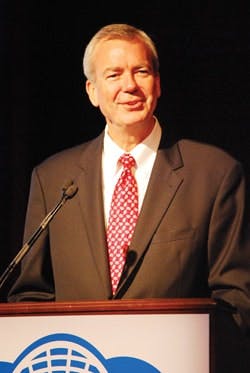"Smart," "safe" and "sustainable" are the "new black" in manufacturing in general and process automation in particular. But, like apple pie and motherhood, while everybody may be in favor of these ideas, implementing them is significantly easier to talk about than to do. This three-fold mantra is a response to the rapidly changing manufacturing environment and its many challenges: volatile and mostly rising energy prices; obsolescence of much manufacturing infrastructure and the power grid; loss of the knowledge base of retiring workers; the need to minimize waste and downtime; and environmental and safety regulatory compliance, to name a few.
In fact, the folks at Rockwell Automation were so taken with the "three Ss" that they made them the theme of this year's Automation Fair, held the first week of November in Orlando, Fla. At the Manufacturing Perspectives media event, which took place the day before the show opened, speakers outlined the many facets of that vision for process manufacturers.
Responding to these demands requires plant-wide approaches to automation and optimization, according to Steve Eisenbrown, Rockwell Automation's senior vice president, architecture and software—not just optimization of a single process, but the entire manufacturing operation, all the way out to the supply chain.
"The way to achieve smart manufacturing is through an agile supply chain, plant-wide automation and sustainable production," said Eisenbrown. "It's a merging of operations and engineering objectives to improve costs and customer responsiveness."
John Nesi, Rockwell Automation's vice president of market development, echoed this theme in his keynote at the Process Solutions User Group (PSUG) 2010, also held in conjunction with Automation Fair. "Investors used to be able to diversify counter-culturally, but since 2000 we've been seeing the slow synchronization of economies across the world. Now, the global synchronization of supply chains has begun too, so speed and innovation are more critical then ever, and optimization within plants will be consistent with their overall enterprise competitiveness," he explained.
One of Rockwell Automation's main approach to this smart plant is its PlantPAx process automation system, an integrated control and information solution. It is a unified platform for both process and discrete operations where visibility into plant operations, asset health and utilization, safety, communications and IT are all integrated, Eisenbrown said.
In a panel discussion about plant-wide optimization using PlantPAx, Larry O'Brien, research director of the ARC Advisory Group, put his finger on the challenge of plant-wide optimization and the trend it represents. "There are still too many islands of information in the plant that need to be bridged," he said. "We're seeing a blurring of real-time and transactional operations. When you can see all the information, you can make sound judgments."
Another panel member, Dwayne Robbins, engineering manager for Weyerhaeuser, brought the benefits of smart manufacturing to life. Weyerhaeuser tied control of the turbines at its cellulose plant into the plant-wide IT system to track the company's use of electricity. The real-time information gained now allows it not only to save power, but to explore the possibilities for generating extra power to sell.
Eisenbrown underlined other savings possible with plant-wide automation. Fonterra of New Zealand is one of the largest producers of milk products in the world, processing 13 billion liters of milk every year. It came to Rockwell Automation to help it improve quality and yield across its entire operation. Using PlantPAx, it increased production rates by 5-15% and quality by 50%. It also increased efficiency by 5-12% and reduced variability on its key control variables. Fonterra's ROI was more than 60% in the first year of its implementation.
On the sustainability front, Nesi reported that optimization of resources also is consistent with goals of overall enterprise efficiency and productivity. "Energy utilization has become top of mind, and environmental concerns are mounting. There's a lot of ‘petro-paranoia' because we have to buy from people who often don't like us and drill in more dangerous areas," said Nesi, who added there's also growing concern about water scarcity problems, cap-and-trade reporting issues, alternative energy markets, smart grid development, smart factories, power cogeneration and biomass recovery, and how to produce more sustainable products and processes.
"The impact of sustainable activities ripples through the whole corporation, and sustainability can become a key enabler for corporate success," he said. "We should all be looking at green initiatives as the next lean initiative."
What about safety? ARC's O'Brien said there has a disturbing increase in the frequency and severity of safety incidents, even though all of them were the result of preventable causes. But recent events have conspired to put safety on the top of many process manufacturing CEOs' to-do lists.
"People put off safety during a recession," O'Brien said. "But a lot of safety system infrastructure is becoming obsolete." And even the companies with the best safety records need to pay attention.
For example, Weyerhaeuser has an enviable safety reputation, with a near-zero incident record. The company had gone two years without an incident when, in June 2009, a million-gallon storage tank exploded, launching its solid-steel construction 35 feet into the air. Fortunately, no one was injured, but "what that brought home to us was the difference in personnel safety vs. process safety," Robbins said. "We took a step back and recognized that process safety is different from personnel safety. We're doing a complete review of all our systems now."
Of course, Rockwell took advantage of this annual gathering to outline its plans to address these major trends. Som Chakraborti, director of Rockwell's process automation business, reported that the company is adding to PlantPAx's capabilities with next quarter's launch of PlantPAx System Release 2.0, and also expanding its channel programs for its process customers with 50 new global solution integrator partners.
"In the past year, we've had PlantPAx successes in a range of applications, including consumer products, life sciences, pulp and paper, cement, minerals and mining, metals, oil and gas, water utilities and power," Chakraborti said. "This has been a very strong trend of adoptions. We began building PlantPAx's system to have a DCS-like appeal, then integrated acquisitions and partnerships to its core, and so now we have a unified PlantPAx DCS and process portfolio. The next phase is expanding PlantPAx for larger projects with high capital expenditures that need high availability, but then also focus on smaller processes capabilities for OEMs."
PlantPAx's new high-availability functions will include HMI data and alarming capabilities, control via Logix L73 and L75 controllers, communications with EtherNet/IP and 1715 Series I/O based on ICS Triplex technology. Chakraborti added that Rockwell also will introduce its AADvance "brains in a box" for SIL 2 safety applications and a new high-density HART I/O module.





